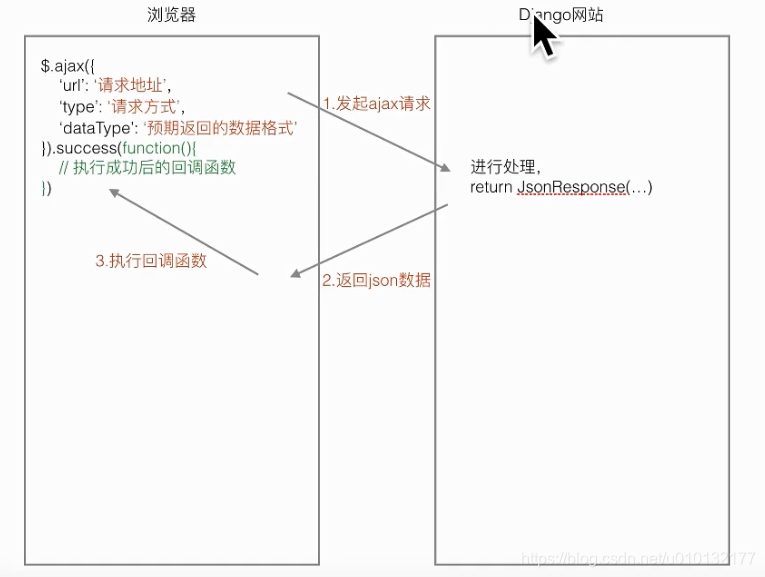详情请点阅读全文
一、Ajax基本概念
【参考】:https://www.runoob.com/jquery/jquery-ajax-intro.html
异步的javascript。在不全部加载某一个页面部的情况下,对页面进行局的刷新,ajax请求都在后台。
图片,css文件,js文件都是静态文件。
1.1ajax基本用法
1 | $.ajax({ |
1.2完整过程示意
1) 发起ajax请求:jquery发起
2) 执行相应的视图函数,返回json内容
3) 执行相应的回调函数。通过判断json内容,进行相应处理。
二、Ajax登录案例
2.1ajax测试案例
第1步,下载 jquery:https://jquery.com/download/
下载第2个开发,未压缩版本 https://code.jquery.com/jquery-3.4.1.js
【1】compressed, production jQuery 3.4.1- 用于实际的网站中,已被精简和压缩。
【2】uncompressed, development jQuery 3.4.1 - 用于测试和开发(未压缩,是可读的代码)
第2步,部署jquery,在根目录下建立 /static/js、css、images、
- 把jquery.js文件放入js文件夹
第3步,设置project1/settings.py,拉到最底下:
设置静态文件的保存目录1
2
3
4
5# Static files (CSS, JavaScript, Images)
# https://docs.djangoproject.com/en/3.0/howto/static-files/
STATIC_URL = '/static/'
STATICFILES_DIRS = [os.path.join(BASE_DIR, 'static')] # 设置静态文件的保存目录
第4步,创建ajax请求示例页面templates/app1/test_ajax.html,
1 | <!DOCTYPE html> |
第5步,配置app1/urls.py
1 | path(r'test_ajax',views.test_ajax),#ajax测试页 |
第6步,编写app1/views.py
- 引入json模块
- ajax测试页面
- ajax请求处理
1
2
3
4
5
6
7
8
9
10
11
12
13
14from django.shortcuts import render,redirect #引入重定向简写模块
from app1.models import BookInfo,AreaInfo #从模型下导入bookinfo数据模型
from django.http import HttpResponse,HttpResponseRedirect,JsonResponse #引入返回请求模块、重新定向模块、json模块
from datetime import date # 引用时间模块
# /test_ajax
def test_ajax(request):
'''显示ajax页面'''
return render(request, 'app1/test_ajax.html')
def ajax_handle(request):
'''接收ajax请求处理,返回json数据'''
# 返回的json数据 {'res':1}
return JsonResponse({'res':1})效果:http://127.0.0.1:8000/test_ajax
点击按钮后,用jquery发起ajax请求,服务器返回请求,jquery处理返回数据,在页面显示出来提示信息,但页面并未整体刷新:
后台的ajax请求查看:
技巧:出错调试也在调试里的network里查看

2.2 ajax的异步和同步请求控制(上步的4步)
还是在templates/app1/test_ajax.html把js部分加上alert(1),2,3查看运行顺序1
2
3
4
5
6
7
8
9
10
11
12
13
14
15
16
17
18
19
20
21
22
23
24
25
26
27
28
29
30
31
32
33
34
35
36
37
38
39
40<!DOCTYPE html>
<html lang="en">
<head>
<meta charset="UTF-8">
<title>ajax</title>
<script src="/static/js/jquery-1.12.4.min.js"></script>
<script>
$(function () {
// 绑定btnAjax的click事件
$('#btnAjax').click(function () {
alert(1)//【1】
$.ajax({
'url': '/ajax_handle',
'dataType': 'json',
// 'async': false, // 【4】同步的ajax请求
}).success(function (data) {
// 进行处理
alert(2)//【2】
if (data.res == 1){
$('#message').show().html('提示信息')
}
})
alert(3)//【3】
})
})
</script>
<style>
#message {
display: none;
color: red;
}
</style>
</head>
<body>
<input type="button" id="btnAjax" value="ajax请求">
<div id="message"></div>
</body>
</html>效果:运行发现运行顺序为1,3,2,而不是预期的1,2,3这即是异步
把第【4】项注释取消,顺序即变成1,2,3,又变回同步
同步设置:'async': false,1
2
3
4
5
6
7
8
9
10
11
12
13
14
15
16
17
18
19
20
21
22<script>
$(function () {
// 绑定btnAjax的click事件
$('#btnAjax').click(function () {
alert(1)//【1】
$.ajax({
'url': '/ajax_handle',
'dataType': 'json',
'async': false, // 【4】同步的ajax请求
}).success(function (data) {
// 进行处理
alert(2)//【2】
if (data.res == 1){
$('#message').show().html('提示信息')
}
})
alert(3)//【3】
})
})
</script>2.3 ajax登录案例
【目标】:实现用户信息输入错误,也不刷新页面清空数据,直接提示错误,省得再次输入信息1) 首先,分析出请求地址时需要携带的参数。
1) 视图函数处理完成之后,所返回的json的格式。
2) 显示出登录页面:
a) 设计url,通过浏览器访问 http://127.0.0.1:8000/login_ajax 时显示登录页面。
b) 设计url对应的视图函数login_ajax。
c) 编写模板文件login_ajax.html:在里面写jquery代码发起ajax请求。2) 然后,登录校验功能
a) 设计url,点击登录页的登录按钮发起请求http://127.0.0.1:8000/login_ajax_check时进行登录校验。
b) 设计url对应的视图函数login_ajax_check: - 接收post提交过来的数据。
- 进行登录校验,并返回json内容。 JsonRepsone
- Json格式如下:
1
2{'res':'1'} #表示登录成功
{'res':'0'} #表示登录失败
第1步,templates/app1/login.html
1 | <!DOCTYPE html> |
第2步,app1/views.py处理函数
- 登录页函数
- 登录校验函数
1
2
3
4
5
6
7
8
9
10
11
12
13
14
15
16
17
18
19
20
21from django.shortcuts import render,redirect #引入重定向简写模块
from app1.models import BookInfo,AreaInfo #从模型下导入bookinfo数据模型
from django.http import HttpResponse,HttpResponseRedirect,JsonResponse #引入返回请求模块、重新定向模块
from datetime import date # 引用时间模块
def login(request):
'''登录页'''
return render(request,'app1/login.html')
def login_check(request):
'''登录校验'''
#1.获取用户名密码
username=request.POST.get('username')
password=request.POST.get('password')
#2.进行校验,并返回json数据
if username=='jim' and password=='123':
#return redirect('/books')
return JsonResponse({'res':1}) #正确返回1
else:
#return redirect('/login')
return JsonResponse({'res':0}) #错误返回0
第3步,app1/ulrs.py配置
1 | path('login/',views.login),#登录页 |
效果:http://127.0.0.1:8000/login/
不正确:则在不刷新页面情况下提示错误信息(用于名,密码都还在,不要再次填写),
正确:则跳转到页面 http://127.0.0.1:8000/books
注意:settings.py别忘记设置
设置静态文件的保存目录
1 | # Static files (CSS, JavaScript, Images) |